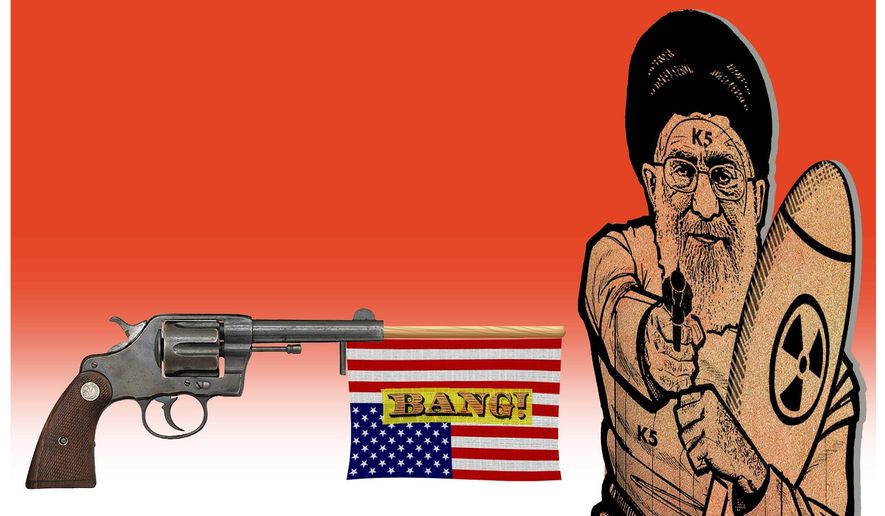OPINION:
Banner headlines in a prominent national newspaper read “NUKE DEAL PAVES WAY FOR NEW ERA: Sworn Foes U.S., Iran Aim To Bury Hatchet” — without sarcasm. For critics of the Iran nuclear deal, such undeserved praise is ominously reminiscent of the adulatory press that greeted British Prime Minister Neville Chamberlain and his ill-fated Munich agreement, upon returning from meeting Adolph Hitler in Nazi Germany on the eve of World War II, declaring, “Peace for our time.”
Critics of the Iran nuclear deal are right — it is a very bad deal. It surrenders to the world’s leading sponsor of international terrorism the right to enrich uranium and the technological pathway to eventually build nuclear weapons, and intercontinental missiles to deliver them, on a mass industrial scale, just as Israeli Prime Minister Benjamin Netanyahu warned the U.S. Congress on March 3, 2015.
The deal, negotiated without the participation of any of the U.S. allies who must live in the Middle East, next door to the existential threat that is a nuclear Iran, is straining those invaluable relationships to the breaking point and making U.S. security guarantees non-credible.
The deal may have started a nuclear arms race in the Middle East already.
According to press reports, Saudi Arabia, which has intermediate-range missiles from China, may purchase nuclear warheads from Pakistan. President Obama’s recent meeting with the Saudis, and Defense Secretary Ashton Carter’s trip to Israel, further evidences the extreme angst among U.S. allies about the Iran nuclear deal.
Indeed, the nuclear deal with Iran will probably make inevitable another war in the Middle East.
Israel’s Netanyahu warns the deal is an “historic mistake” and “worse than the deal … that led to a nuclear arsenal in North Korea” and that Israel will do what it must to protect itself. The deal is so bad that it may achieve the seemingly impossible — a coalition of Israel and the moderate Arab states to launch a pre-emptive war against Iran’s nuclear and missile programs.
Such a war would destabilize the global economy and quite possibly involve weapons of mass destruction.
Iran has hundreds of missiles capable of striking Israel and the oil fields in Saudi Arabia, the UAE, and Iraq with conventional and, reportedly, chemical warheads. The nuclear deal by lifting economic sanctions will gift Iran with $150 billion that could be used to sponsor unprecedentedly destructive terror attacks worldwide — and perhaps to purchase nuclear weapons from North Korea, Iran’s strategic partner by treaty.
Some U.S. and Israeli experts assess that Iran has already clandestinely developed nuclear weapons and is following the example of North Korea. The Clinton Administration negotiated an Agreed Framework intended to dismantle nuclear weapons built by North Korea secretly. But North Korea cheated, continuing to build-up their nuclear and missile programs until they became irreversible, while reaping economic and political benefits from the Agreed Framework.
President George W. Bush should have heeded Ash Carter (now Secretary of Defense) and former Defense Secretary William Perry, who in a 2006 article urged surgical strikes to prevent North Korea from developing the long-range missiles that threaten the United States today. On April 7, 2015, the North American Aerospace Defense (NORAD) commander, Adm. William Gortney, warned at a press conference that North Korea’s KN08 intercontinental ballistic missile is assessed as having a nuclear warhead, and that NORAD is spending $700 million to further harden its bunker inside Cheyenne Mountain from electromagnetic pulse (EMP) attack.
North Korea and Iran have both orbited satellites on trajectories that appear to practice evading U.S. national missile defenses and early warning radars by flying on south polar trajectories at altitudes consistent with making a surprise EMP attack on the 48 contiguous United States. The Congressional EMP Commission warned that a nuclear EMP attack could blackout the national electric grid and other life sustaining critical infrastructures for months or years, starving America to death. “Death to America” would become reality, not merely an Iranian chant — achievable by the high-altitude detonation of a single nuclear weapon.
Because a single nuclear weapon could achieve “Death to America” by EMP attack, the Iran nuclear deal must be airtight and absolutely sure the mullahs cannot acquire — and do not now have — even one nuclear weapon. Congress should challenge the Obama Administration’s claim that they have, essentially, “slam dunk” intelligence that meets this impossible standard.
Given the plethora of concessions over the last two years, Congress should now require President Obama to trash this badly flawed nuclear deal, increase sanctions, shoot down any Iranian satellites and long-range missile tests, and materially support dissidents and the majority of Iran’s people who want regime change.
Congress should pass the Critical Infrastructure Protection Act to protect the national electric grid and the American people from an EMP apocalypse — immediately.
By the way, on June 13 an Iranian article — with artwork depicting a satellite making an EMP attack from above the globe — announced that Iran circumvented the international sanctions regime to acquire EMP filters, and is now making its own filters, to harden Iran’s critical assets against nuclear EMP.
• Ambassador R. James Woolsey was director of Central Intelligence and is chairman of the Foundation for Defense of Democracies. Peter Vincent Pry is executive director of the EMP Task Force on National and Homeland Security.




Please read our comment policy before commenting.